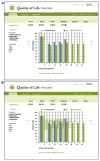User-centered design of quality of life reports for clinical care of patients with prostate cancer
- PMID: 24787105
- PMCID: PMC4237217
- DOI: 10.1016/j.surg.2013.12.007
User-centered design of quality of life reports for clinical care of patients with prostate cancer
Abstract
Background: Primary treatment of localized prostate cancer can result in bothersome urinary, sexual, and bowel symptoms. Yet clinical application of health-related quality-of-life (HRQOL) questionnaires is rare. We employed user-centered design to develop graphic dashboards of questionnaire responses from patients with prostate cancer to facilitate clinical integration of HRQOL measurement.
Methods: We interviewed 50 prostate cancer patients and 50 providers, assessed literacy with validated instruments (Rapid Estimate of Adult Literacy in Medicine short form, Subjective Numeracy Scale, Graphical Literacy Scale), and presented participants with prototype dashboards that display prostate cancer-specific HRQOL with graphic elements derived from patient focus groups. We assessed dashboard comprehension and preferences in table, bar, line, and pictograph formats with patient scores contextualized with HRQOL scores of similar patients serving as a comparison group.
Results: Health literacy (mean score, 6.8/7) and numeracy (mean score, 4.5/6) of patient participants was high. Patients favored the bar chart (mean rank, 1.8 [P = .12] vs line graph [P < .01] vs table and pictograph); providers demonstrated similar preference for table, bar, and line formats (ranked first by 30%, 34%, and 34% of providers, respectively). Providers expressed unsolicited concerns over presentation of comparison group scores (n = 19; 38%) and impact on clinic efficiency (n = 16; 32%).
Conclusion: Based on preferences of prostate cancer patients and providers, we developed the design concept of a dynamic HRQOL dashboard that permits a base patient-centered report in bar chart format that can be toggled to other formats and include error bars that frame comparison group scores. Inclusion of lower literacy patients may yield different preferences.
Copyright © 2014 Mosby, Inc. All rights reserved.
Figures


Similar articles
-
Relevance of graph literacy in the development of patient-centered communication tools.Patient Educ Couns. 2016 Mar;99(3):448-454. doi: 10.1016/j.pec.2015.09.009. Epub 2015 Oct 9. Patient Educ Couns. 2016. PMID: 26481910
-
Design and feasibility of integrating personalized PRO dashboards into prostate cancer care.J Am Med Inform Assoc. 2016 Jan;23(1):38-47. doi: 10.1093/jamia/ocv101. Epub 2015 Aug 9. J Am Med Inform Assoc. 2016. PMID: 26260247 Free PMC article.
-
The impact of home care nurses' numeracy and graph literacy on comprehension of visual display information: implications for dashboard design.J Am Med Inform Assoc. 2018 Feb 1;25(2):175-182. doi: 10.1093/jamia/ocx042. J Am Med Inform Assoc. 2018. PMID: 28460091 Free PMC article.
-
The effect of androgen deprivation therapy on health-related quality of life in men with prostate cancer.Urology. 2001 Aug;58(2 Suppl 1):94-100. doi: 10.1016/s0090-4295(01)01250-x. Urology. 2001. PMID: 11502459 Review.
-
Patient-reported outcome (PRO) questionnaires for men who have radical surgery for prostate cancer: a conceptual review of existing instruments.BJU Int. 2017 Oct;120(4):468-481. doi: 10.1111/bju.13896. Epub 2017 May 30. BJU Int. 2017. PMID: 28437031 Review.
Cited by
-
Integrating Patient-Reported Outcomes into Spine Surgical Care through Visual Dashboards: Lessons Learned from Human-Centered Design.EGEMS (Wash DC). 2015 Mar 13;3(2):1133. doi: 10.13063/2327-9214.1133. eCollection 2015. EGEMS (Wash DC). 2015. PMID: 25988187 Free PMC article.
-
Data Visualizations to Support Health Practitioners' Provision of Personalized Care for Patients With Cancer and Multiple Chronic Conditions: User-Centered Design Study.JMIR Hum Factors. 2018 Oct 16;5(4):e11826. doi: 10.2196/11826. JMIR Hum Factors. 2018. PMID: 30327290 Free PMC article.
-
Graphical user interface design to improve understanding of the patient-reported outcome symptom response.PLoS One. 2023 Jan 24;18(1):e0278465. doi: 10.1371/journal.pone.0278465. eCollection 2023. PLoS One. 2023. PMID: 36693053 Free PMC article.
-
Designing for impact: identifying stakeholder-driven interventions to support recovery after major cancer surgery.Support Care Cancer. 2018 Dec;26(12):4067-4076. doi: 10.1007/s00520-018-4276-0. Epub 2018 Jun 6. Support Care Cancer. 2018. PMID: 29876832 Free PMC article.
-
Patient Perspectives to Inform a Health Literacy Educational Program: A Systematic Review and Thematic Synthesis of Qualitative Studies.Int J Environ Res Public Health. 2019 Nov 5;16(21):4300. doi: 10.3390/ijerph16214300. Int J Environ Res Public Health. 2019. PMID: 31694299 Free PMC article.
References
-
- Gore JL, Kwan L, Lee SP, Reiter RE, Litwin MS. Survivorship beyond convalescence: 48-month quality-of-life outcomes after treatment for localized prostate cancer. J Natl Cancer Inst. 2009;101:888–92. - PubMed
-
- Litwin MS, Hays RD, Fink A, Ganz PA, Leake B, Leach GE, et al. Quality-of-life outcomes in men treated for localized prostate cancer. JAMA. 1995;273:129–35. - PubMed
-
- Sanda MG, Dunn RL, Michalski J, Sandler HM, Northouse L, Hembroff L, et al. Quality of life and satisfaction with outcome among prostate-cancer survivors. N Engl J Med. 2008;358:1250–61. - PubMed
-
- Stanford JL, Feng Z, Hamilton AS, Gilliland FD, Stephenson RA, Eley JW, et al. Urinary and sexual function after radical prostatectomy for clinically localized prostate cancer: the Prostate Cancer Outcomes Study. JAMA. 2000;283:354–60. - PubMed
-
- Hartzler A, Olson KA, Dalkin B, Gore JL. Enhancing communication after treatment: what cancer patients want from a quality of life dashboard. AMIA Annu Symp Proc. 2011;2011:1795.
Publication types
MeSH terms
Grants and funding
LinkOut - more resources
Full Text Sources
Other Literature Sources
Medical

